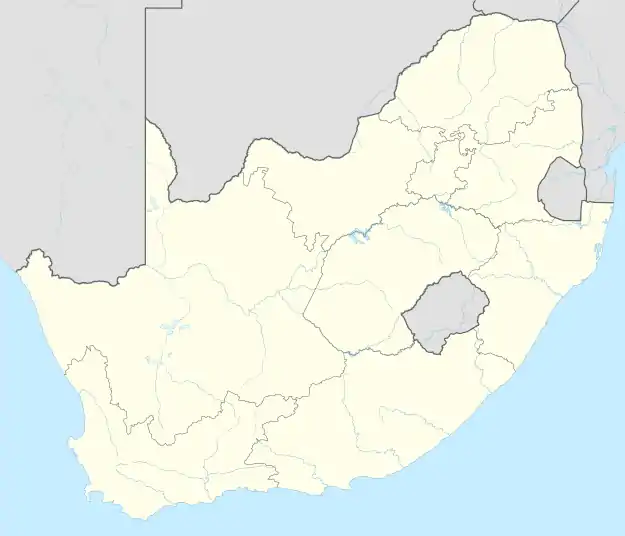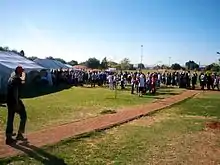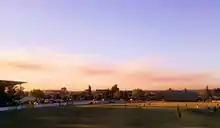Lenasia
Lenasia, often called Lenz, is a township south of Soweto in Gauteng Province, South Africa, originally created to house Indians. It is part of the City of Johannesburg Metropolitan Municipality. Lenasia is approximately 35 kilometres southwest of the Johannesburg Central Business District and 45 kilometres south of the Sandton Central Business District.
Lenasia
Lenz | |
|---|---|
 Lenasia  Lenasia | |
| Coordinates: 26°19′1″S 27°49′40″E | |
| Country | South Africa |
| Province | Gauteng |
| Municipality | City of Johannesburg |
| Area | |
| • Total | 20.28 km2 (7.83 sq mi) |
| Population (2011)[1] | |
| • Total | 89,714 |
| • Density | 4,400/km2 (11,000/sq mi) |
| Racial makeup (2011) | |
| • Black African | 40.4% |
| • Coloured | 2.6% |
| • Indian/Asian | 55.9% |
| • White | 0.2% |
| • Other | 0.9% |
| First languages (2011) | |
| • English | 55.4% |
| • Zulu | 8.8% |
| • Tswana | 8.2% |
| • Sotho | 6.4% |
| • Other | 21.2% |
| Time zone | UTC+2 (SAST) |
| Postal code (street) | 1821 |
| PO box | 1827 |
| Area code | 011 |
History
Early history
Apartheid-era planners situated the group area for Johannesburg's Indians near the Lenz Military Base. It originates from 1958.[2] According to Parnell and Pirie the foundations for Lenasia were laid in 1963.[3] The name "Lenasia" is thought to be a combination of the words "Lenz" and "Asia". The Lenz in question was one Captain Lenz who owned the original plot on which Lenasia is situated. Many of its early residents were forcibly removed under the Group Areas Act from Pageview and the portion of Vrededorp populated by non whites (jointly known as Fietas) and Fordsburg, areas close to the Johannesburg city centre, to Lenasia. As segregation grew it became the largest place where people of Indian extraction could legally live in the Transvaal Province.
Geography
Cityscape
The township is large, and divided into extensions (Extensions 1-13) including a major suburb south of Lenasia, which is called Lenasia South and referred to as Daxina by the locals.[4]
Communities
The younger generation tend to travel out of Lenasia to work for the big corporates. The growing population of Lenasia is a huge concern, as no additional land is being zoned for suburban development. Hence properties soar to exorbitant prices, making it more and more difficult for entry level income earners to afford to live there.
Many of the younger generation are now beginning to move out of the suburb because of increasing home prices, major traffic congestion en route to the city, as well as wanting to live in a more multicultural environment.
Although still a predominantly Indian area, Lenasia today is a more cosmopolitan and diverse suburb, providing a place to live for local coloured and African people, as well as recent immigrants and refugees.
Climate
Weather in Lenasia is typically 2-3 degrees cooler than central Johannesburg due to the town being situated within a valley.
Economy
Lenasia is now a vibrant and thriving community. The rapidly growing suburb has shopping malls (Trade Route Mall & Signet Terrace Shopping Centre), churches, mandirs, mosques, banks and various industrial and commercial sectors such as Kulfi Ice-cream and DB Sweets which are familiar household business names. It also boasts takeaways such as Akhalwayas known for its famous fish and chips and Delhi Delicious for its pies.
It also boasts numerous other restaurants with well known franchises such as KFC, Wimpy, McDonald's and Burger King.
There are several prominent publications and newspapers based in Lenasia such as Lenasia Times, and the Rising Sun Newspaper.
Four satellite radio stations, Radio Islam, Eastwave FM, Channel Islam International and Lenz Fm broadcast from Lenasia.
Lenasia embraced the digital age when in 2002 a community website lenzinfo was launched, which keeps the community informed on happenings, sports events, religious and cultural activities and general information.
Law and government
Government
It is located in Region G of the City of Johannesburg Metropolitan Municipality.
Politics
The community of Lenasia played a prominent role in opposing the national tricameral elections held in 1984 and 1989 under the apartheid era National Party government. This was an attempt to create separate legislative assemblies in South Africa for Whites, Indians and Coloureds in order to entrench racial segregation and perpetuate the disenfranchisement of the African majority in South Africa. Lenasia also played a role in the creation and activities of the United Democratic Front (UDF), the mass democratic movement that opposed apartheid in the 1980s and early 1990s before the unbanning of the African National Congress. Many of Lenasia's residents played a prominent role in the UDF structures and the broader anti-apartheid movement. Some of these activists became senior political figures after the first national democratic elections in 1994.
Parks and greenspace

Rose Park a popular venue amongst Lenasia residents for public events and for family relaxation on weekends. The park, which consists of aesthetically-pleasant rose bushes and a fountain, also has a special stimulation and play area that are specifically for children with disabilities. It also featured as a fan park during the 2010 FIFA World Cup.
Rose Park is also the venue for the popular parkrun', which takes place every Saturday at 8am.
Sport
Cricket

The GM LPL (Lenasia Premier League) is a prominent annual Twenty20-styled cricket tournament played during September. It commenced in 2010.
Religious places
Shree Rameshwar Mahadev Mandir
Shree Rameshwar Mahadev Mandir is situated in Lenasia. The Mandir was built by the community, for the Community in 1988. The main aim is to promote, support, and perpetuate the worship of Shree Rameshwar Mahadev, to celebrate religious festivals, holy days & charitable events, and the continuous worship & spiritual guidance from Shree Rameshwar Mahadev.[5]
Noted residents
- Feroza Adam, political activist
- Candice Morgan, actor and Miss Deaf World SA
- Ahmed Kathrada, ANC activist
- Mahatma Gandhi, led protests against colonial British rule at Lenasia Train Station
- Abu Baker Asvat, medical doctor and political activist
References
- "Main Place Lenasia". Census 2011.
- Raper, Peter E.; Moller, Lucie A.; du Plessis, Theodorus L. (2014). Dictionary of Southern African Place Names. Jonathan Ball Publishers. p. 1412. ISBN 9781868425501.
- Parnell, Susan and Gordon Pirie (1991) Johannesburg. In Anthony Lemon (eds) Homes apart: South Africa’s segregated cities. Bloomington: Indiana University Press pp 129-145
- "Home :: Shree Rameshwar Mahadev Mandir". www.rameshwarmandir.org.za. Retrieved 2020-09-16.
External links
| Wikimedia Commons has media related to Lenasia. |
- Lenasia's Very Own Website
- Lenasia Times Newspaper (town's oldest publication)
- https://web.archive.org/web/20081003085734/http://lenzwatch.co.za/
- Lenasia Crime Alert
- Lenasia News & Events Publication
- https://web.archive.org/web/20140517225726/http://lenasiainfo.com/
- Sporting history of Lenasia
- Lakshmi Narayan Temple, Ramakrishna Vedanta Society